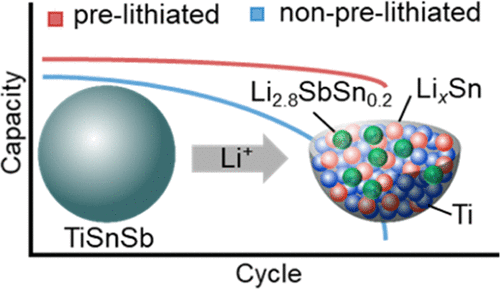当前位置:
X-MOL 学术
›
Chem. Mater.
›
论文详情
Our official English website, www.x-mol.net, welcomes your
feedback! (Note: you will need to create a separate account there.)
Lithiation Mechanism and Improved Electrochemical Performance of TiSnSb-Based Negative Electrodes for Lithium-Ion Batteries
Chemistry of Materials ( IF 7.2 ) Pub Date : 2021-10-22 , DOI: 10.1021/acs.chemmater.1c01809 Joop Enno Frerichs 1 , Mirco Ruttert 2 , Jonas Koppe 1 , Mathis Radzieowski 3 , Martin Winter 2, 4 , Tobias Placke 2 , Michael Ryan Hansen 1
Chemistry of Materials ( IF 7.2 ) Pub Date : 2021-10-22 , DOI: 10.1021/acs.chemmater.1c01809 Joop Enno Frerichs 1 , Mirco Ruttert 2 , Jonas Koppe 1 , Mathis Radzieowski 3 , Martin Winter 2, 4 , Tobias Placke 2 , Michael Ryan Hansen 1
Affiliation

|
Lithium alloying materials are promising candidates to replace the current intercalation-type graphite negative electrode materials in lithium-ion batteries (LIBs) due to their high specific capacity and relatively low cost. Here, we investigate the electrochemical performance of TiSnSb regarding its charge/discharge cycling stability as a negative electrode material in LIB cells. To assess a more practical performance with respect to a limited active lithium content in LIB full-cells, we evaluate the impact of pre-lithiation for TiSnSb with respect to the cycling stability in a NCM111||TiSnSb cell setup. The observation of the individual electrode potentials reveals comprehensive insights into the ongoing cell chemistry, showing that clear performance improvements can be achieved via pre-lithiation. Furthermore, the lithiation mechanism of TiSnSb is systematically studied via ex situ7Li magic-angle spinning (MAS) nuclear magnetic resonance (NMR), ex situ X-ray diffraction, and static ex situ119Sn wideband uniform rate smooth truncation Carr–Purcell Meiboom–Gill (CPMG) WCPMG NMR experiments. For comprehensive references regarding the isotropic 7Li shift of the Li–Sb intermetallic phases, all thermodynamically stable Li–Sb intermetallics of the binary Li–Sb systems have been synthesized and subsequently characterized by 7Li MAS NMR. Combined, our measurements for lithiated TiSnSb do not give any evidence for the formation of Li–Sn and Li–Sb intermetallics related to crystalline bulk phases (Li7Sn3, Li7Sn2, Li3Sb, and Li2Sb) as has been previously reported. In contrast, unique insights obtained from static ex situ119Sn WCPMG NMR and ex situ XRD measurements reveal the formation of ternary Li–Sb–Sn species during lithiation, which can be assigned to the intermetallic phase Li2.8SbSn0.2. Additionally, the 7Li MAS NMR measurements combined with the observed discharge capacity reveal a second Li species, which we assign to an amorphous Li–Sn phase.
中文翻译:

锂离子电池用 TiSnSb 基负极的锂化机制和改进的电化学性能
锂合金材料由于其高比容量和相对较低的成本,是替代锂离子电池(LIB)中当前嵌入型石墨负极材料的有希望的候选材料。在这里,我们研究了 TiSnSb 作为 LIB 电池负极材料的充放电循环稳定性方面的电化学性能。为了在 LIB 全电池中有限的活性锂含量方面评估更实用的性能,我们评估了 TiSnSb 预锂化对 NCM111||TiSnSb 电池设置中循环稳定性的影响。单独电极电位的观察揭示了全面见解正在进行的电池化学,显示出明显的性能改进,可以实现通过预锂化。此外,TiSnSb的锂化机构被系统地研究通过易地7栗魔角旋转(MAS)核磁共振(NMR),易地X射线衍射,和静态易地119 Sn的宽带均匀速率平滑截断卡尔赛尔Meiboom-Gill (CPMG) WCPMG 核磁共振实验。对于关于Li-Sb 金属间相的各向同性7 Li 位移的综合参考,已经合成了二元 Li-Sb 系统的所有热力学稳定的 Li-Sb 金属间化合物,随后用7李 MAS 核磁共振。结合起来,我们对锂化 TiSnSb 的测量没有给出任何与晶体体相(Li 7 Sn 3、Li 7 Sn 2、Li 3 Sb 和 Li 2 Sb)相关的 Li-Sn 和 Li-Sb 金属间化合物形成的证据,如之前已经报道过。相比之下,从静态非原位119 Sn WCPMG NMR 和非原位XRD 测量获得的独特见解揭示了锂化过程中三元 Li-Sb-Sn 物种的形成,这可以归因于金属间相 Li 2.8 SbSn 0.2。此外,7Li MAS NMR 测量结合观察到的放电容量揭示了第二种 Li 物质,我们将其指定为非晶态 Li-Sn 相。
更新日期:2021-11-09
中文翻译:

锂离子电池用 TiSnSb 基负极的锂化机制和改进的电化学性能
锂合金材料由于其高比容量和相对较低的成本,是替代锂离子电池(LIB)中当前嵌入型石墨负极材料的有希望的候选材料。在这里,我们研究了 TiSnSb 作为 LIB 电池负极材料的充放电循环稳定性方面的电化学性能。为了在 LIB 全电池中有限的活性锂含量方面评估更实用的性能,我们评估了 TiSnSb 预锂化对 NCM111||TiSnSb 电池设置中循环稳定性的影响。单独电极电位的观察揭示了全面见解正在进行的电池化学,显示出明显的性能改进,可以实现通过预锂化。此外,TiSnSb的锂化机构被系统地研究通过易地7栗魔角旋转(MAS)核磁共振(NMR),易地X射线衍射,和静态易地119 Sn的宽带均匀速率平滑截断卡尔赛尔Meiboom-Gill (CPMG) WCPMG 核磁共振实验。对于关于Li-Sb 金属间相的各向同性7 Li 位移的综合参考,已经合成了二元 Li-Sb 系统的所有热力学稳定的 Li-Sb 金属间化合物,随后用7李 MAS 核磁共振。结合起来,我们对锂化 TiSnSb 的测量没有给出任何与晶体体相(Li 7 Sn 3、Li 7 Sn 2、Li 3 Sb 和 Li 2 Sb)相关的 Li-Sn 和 Li-Sb 金属间化合物形成的证据,如之前已经报道过。相比之下,从静态非原位119 Sn WCPMG NMR 和非原位XRD 测量获得的独特见解揭示了锂化过程中三元 Li-Sb-Sn 物种的形成,这可以归因于金属间相 Li 2.8 SbSn 0.2。此外,7Li MAS NMR 测量结合观察到的放电容量揭示了第二种 Li 物质,我们将其指定为非晶态 Li-Sn 相。











































 京公网安备 11010802027423号
京公网安备 11010802027423号